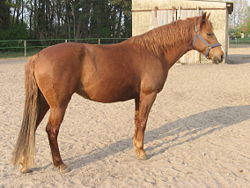|
Home Horse Breeds | First Posted June 24, 2009 May 13, 2020 | |
The Barb Horse
History There are several varieties including Algerian, Moroccan and Tunisian. This is the foundation breed of the West African Barb and the Spanish Barb which was developed in the United States. The Barb horse traces back through antiquity to the time of the Persians and Scythians, in the area of the Fertile Crescent (NE from the Mediterranean Sea, between the Tigris and Euphrates River, then SE to the Persian Gulf.) Just how these people came to possess the horse is not yet known, nor is it known for how long a period of time they had it before they gave some to King Soloman in approximately 1950 B.C., but that gift was the source of the Barb to the Jewish-Hebrew people, the Israelites. The Jewish-Hebrews moved into and through many areas over the years. Significant to this history is their time in Africa and Spain, where they followed marauding Ishmaelites in their conquests, and provided the Barb as a warhorse to both Ishmaelites and Berbers. (Thus came the name Barb, as the Berbers were notoriously Barbarian in nature.) The Ishmaelite conquests included almost all of Africa, Spain, Portugal, and parts of France. They were heading for New Britain but were finally stopped due to the determination of the Franks (of Germanic descent), and because they were by then saturated with war and spoils. Also, typical of people, politics was involved and there was much infighting among the tribes. The Barb, always serving as a superlative warhorse, remained in the hands of the Jewish-Hebrew people. Some of the horses remained in Africa, where for many years the people of Morocco placed great value in them. Most (with the advent of oil and wealth) have been lost or mixed with other breeds. The Barb that still exists in Morocco, Algeria, and Libya, by our research, is not the same horse as the Barb was at the time of the Spanish conquest of the "New World," but in the intervening time from then to now, has been changed into more of a show horse, as those people no longer have a need for a "war horse." Barbs stayed in Spain for many years through Spain's defeat and finally, some 400 years later, through her victory over the Moors. This victory again was due to the Franks who survived the Moorish conquests and had afterward grown in numbers. As Spain's power grew, she sent explorers to the New World, among these the Conquistadors. At that time, the Jewish-Hebrew, still in possession of the Barb, had met with the hatred of King Ferdinand. Most fled back to North Africa but some, disguised as Conquistadors, came with the Barb to America. King Ferdinand on learning of this sent an army expressly for the destruction of the Jewish-Hebrew and succeeded almost completely. The horses they had brought with them, the Barb, stayed and thrived. As with other breeds and types of horses the Barb went various routes. Some became feral, others were used by ranchers, and still others were possessed by Indians. Of these groups, very few remained pure. Research and evidence indicate that the original Nez Perce horse was the spotted Barb, but once the cavalry took custody of the Indians, the stallions were destroyed or castrated and the mares bred to draft breeds. A few Indians broke away from the Chief Joseph chase and went to the Kiamichi mountain area of Oklahoma taking some of their original horses with them, and some of those remained pure. Some of the feral bands stayed pure also, having existed in some virtually inaccessible areas. In the 1950s a few of these that could still be found and taken were gathered and built into a nucleus stock. Some of that nucleus, (called by some of the old timers "the originals"), was mixed with other breeds and this mix was labeled "wild mustangs." A few of those"originals" that comprised the nucleus. The Lemhi-Shoshone also gave Chief Joseph 30-50 barb horses when he was evading the U.S. Army. As a result, many of these horses were slaughtered by the U.S. Army in the years to follow mainly because the Army's horses could not keep up with them because of their traits. Physical Description: The Barb horse has great endurance, is alert, smart, spirited, intelligent, stands between 13.2-15 hh, weighs 875-950 pounds, fully matures as late as 9 years of age, has low set wide eyes, crescent shaped, large nostrils, small ears to medium sized ears, a muscular but graceful neck, short coupling, (5 lumbar vertebrae rather than 5 and a fused piece or 6; 16 or 17 rather than 18 pairs of ribs), deep, strong loins, longer than usual underline, well defined barrel, low set tail, long croup but well balanced, good bone, large joints, strong tendons and ligaments, rounded, strong hoof, and come in a variety of colors: dun, black, blue roan, chestnut, bay, palomino, bay and others. For More Information:
Follow this excellent link for the above information
Sources: |